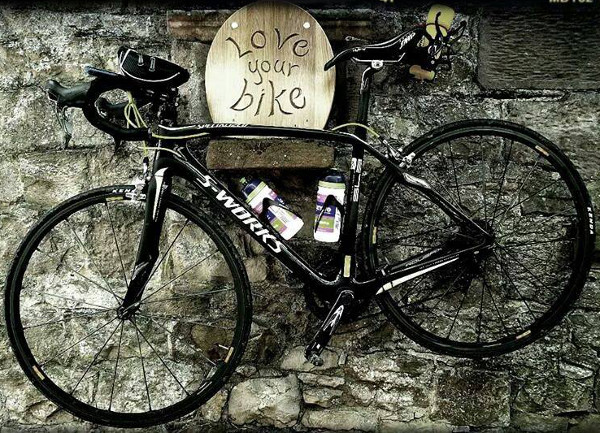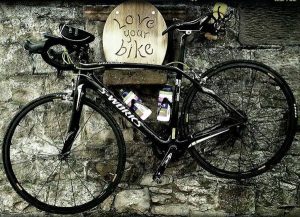“The bicycle is the most civilized conveyance known to man. Other forms of transport grow daily more nightmarish. Only the bicycle remains pure in heart.” – Iris Murdoch
Contents
What is cycling?
Cycling is the action of riding a bicycle, tricycle, unicycle, quadracycle, or other human-powered vehicle, and the term is thought to originate from the process of turning a crank with pedals to rotate the wheels.
There is some debate as to the first bicycle. In the early 1800s the Draisine, Laufmaschine or Dandy Horse was invented in Germany by Baron Karl von Drais, and this is considered to be the first instance of transport on two wheels, and the forerunner of the bicycle. Put simply, it was a plank of wood with a seat and handlebars, atop two steel-rimmed wheels. It’s the template for today’s balance bike – a great way to start children riding.

Once again it’s unclear who invented the first pedal-powered bicycle but in the mid-19th century the velocipede or boneshaker, which used a crank and pedals attached to the front wheel, became popular in countries such as France, the UK and the US. Its popularity waned partly because of the rough ride on unmade roads with steel wheels but also because the wheels were not of sufficient size to enable much in the way of speed.
The high-wheel or penny-farthing followed to enable higher speeds, with solid rubber tyres, but it was dangerous and expensive, so it wasn’t until the advent of the safety bicycle (so called in response to the dangerous nature of the penny-farthing) in the 1880s, with a chain driven back wheel, that the cycling revolution began and new designs came thick and fast. In 1888 John Dunlop invented the inflatable rubber tyre which led to the standardisation of the modern diamond frame, and the price of bicycles fell.
Evolution of the bicycle.
The safety bicycle gradually became the roadster model, and this ‘sit-up-and-beg’ design lasted well into the middle of the 20th Century as its popularity increased and the average person could travel around under their own steam to work, socialise and enjoy leisure time. The bicycle’s ubiquity accelerated the emancipation of women from the 1890s as it increased the range of mobility and freed women somewhat from the restrictions of their corsetry and voluminous dresses as these became unwearable when riding a bicycle.
The frame was adapted to be more aerodynamic with a more hunched-over riding position and thinner tyres. Drop handlebars were added and after the 1940s, derailleur gears too, and the ‘racer’ overtook the roadster in popularity around the middle of the 20th Century. Modifications followed, such as flat handlebars, in the 1960s, then the mountain bike in the 1970s, which relaxed the riding position and made the frame more sturdy for riding off-road.

What are the benefits of cycling?
Social
The private car, since mass production began in the 1920s, has mainly moved from a convenient way to run around town and visit the countryside on the weekend to a way to sit in traffic for twenty minutes during the three-mile daily commute to the office. For at least two generations, planning and transport policy has suppressed cycling across all sectors of society. This decline in physically-active transport has been a significant contributor to ill-health of many types; public and media attention often focus on obesity but in fact the impact is much wider (see below). We need to reverse this trend, and to come up with a radical vision centred on bicycle travel.
Today, motor transport still takes priority in the allocation of investment. As a consequence, the UK lags behind many European countries in levels of active travel. To return cycling to levels that can contribute to a healthy society, changes are needed in policy and practice. This would save billions of pounds in healthcare and social care costs, as well as reducing our dependence on the oil industry.
The world has prioritised mobility when we should have prioritised accessibility – access to the goods and services people need without unnecessary travel.
Cycling improves road safety, both in terms of greater awareness (because drivers are themselves cyclists) and in terms of lower numbers of vehicles and the slower speeds of cyclists. Fewer cars mean less stressful and more cohesive neighbourhoods.

Environmental
Bicycles emit no CO2 in use. Governments are not yet really tackling global climate change but in coming years will be forced to do so by extreme weather events, mass migration, crop failures and other consequences of a changing climate.
More cycling will lead to improved air quality, especially in urban areas.
Cycling vastly reduces resource use (including petrochemicals) compared to the manufacture and use of cars.
Health
Cycling is an easy and accessible way for individuals to incorporate physical activity into their daily lives, reducing the risk of:
- cardiovascular disease
- many forms of cancer
- type-2 diabetes
- depression and other forms of mental ill-health
How to fix a puncture.
Cycling also helps:
- build and maintain bone strength
- maintain a healthy weight
- increase fitness, and therefore quality of life
- improve mental alertness and motivation
- encourage independence – especially in children
- reduce cholesterol levels
- increase life expectancy
Financial
Bicycles are cheaper than cars, don’t require fuel, you don’t need to buy a ticket and repairs are generally cheaper than for a motor vehicle.

What can I do?
Getting a bike
Bikes are cheaper now than they’ve ever been. Your great-great-great-grandma might have had to pay a year’s wages for a bike if she worked below stairs.
As the saying goes – buy cheap, buy twice. Avoid catalogue bikes. A budget bike can be less than £300, a quality hybrid from £400. You don’t need fashionable components like suspension or disc brakes.
If a used bike’s price seems too good to be true, you’re probably sponsoring crime. Ask to see the original receipt. Bikes wouldn’t be stolen if there weren’t people willing to buy them.

Kit
All you need is the bike, lights, mudguards and wet weather gear in winter, a good lock and a rack and panniers if you’re going to carry a lot of gear.
You really don’t need any cushioned spandex unless you’re riding very long distances. Look to cycling nations for what you need, not North America.
Maintenance
Look for a basic bike maintenance course, make sure you can fix a puncture, lubricate moving parts relatively regularly, and carry a pump with you (and tyre levers and a spare tube, unless you’re happy to push your bike home if you get a puncture). Most bike shops will provide an annual service relatively cheaply.
Safety
By all means get a helmet, but a cycle training course is more important. Of the tiny number of fatalities in London annually (around 10) a helmet would almost never have helped. Motorcyclists are the most vulnerable on the roads, then come pedestrians and only then come cyclists.
Never undertake vehicles, especially HGVs at the lights if there’s a left turn. Cycle the width of a car door from parked cars. The majority of cycle accidents in zones 1 and 2 in London involve stationary car doors.
Smile at other road users. Look behind you regularly. Don’t wear headphones. Listen for poor quality car gear changes behind you – men under 24 can be dangerous, but you’ll hear their driving before you see them. The greatest risks you’ll face will be from fellow cyclists and pedestrians.
The safest way of transporting kids is in trailers, which make great prams when fitted with a third wheel.
Storage / security
Most bikes are stolen from shared hallways. A quality bike doesn’t have to look quality. Avoid posh racing bikes (you don’t need one unless you’re a professional racer). Bromptons are highly sought after by thieves.

Cycling
Cycling can be fitted into daily routines, is relatively gentle and requires no special clothing or competitive element. Changing habits requires an initial effort, and the first few times are always the hardest. Once a change of behaviour is completed for two to three weeks the choice becomes habitual, so it’s starting that’s the challenge.
You can overcome this by attempting changes of habit in a group, or, if you don’t like the sound of that, create your own realistic targets, such as cycling once a week, where you would normally go by other means. As it gets easier you can start to add more days. Start in the summer to make it easier.
Learn to use your gears. Motorists make good cyclists – they start off in a low gear. If you have to get out of the saddle to ride, you either live in the alps or you’re in the wrong gear.
Once cycling becomes a habit, you’ll find yourself wanting to cycle everywhere, including social engagements, and you can really call yourself a cyclist. Good luck!
Specialist(s)
Thanks to James Burden of Sustrans and Barnaby Stutter for information, and Greystoke Cycle Cafe for the main image.



2 Comments
I think it woul be valuable to add information about ebikes to this page. They’re very good quality nowadays, affordable new and there’s lots available second-hand. They open up cycling possibilties to the time poor, less-physically fit, those that carry loads (panniers and/or trailer), and in places where it isn’t flat. I came across this excellent video the other day: https://www.youtube.com/watch?v=p9kx1Vu-ecE “Si has decided to find out if you really can give up the car in winter and ride an e-bike all year round instead!” with his 2 kids.
Hi Ryan – good idea. I got your email with a suggestion for a blog article – I’ll contact them. Thanks.